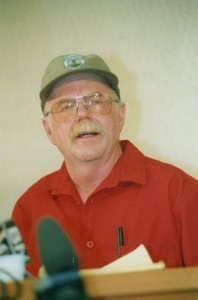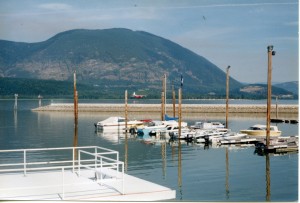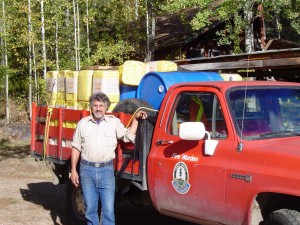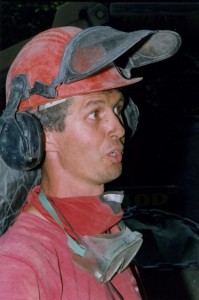Ground assault
With an air assault in place and attempts made to hold the fire in check, it was time to organize a ground crew. With crew safety paramount, the first task was to establish escape routes and safe areas. Salmon Arm Zone dispatched two Fire Wardens to assess the situation from the ground and establish a safe route in for the heavy equipment and initial attack crews.
On July 30th, Fire Boss Roy Benson was assigned to the Silver Creek Fire and, as the Incident Commander, designed a plan of attack. Benson was ultimately responsible for decisions made on the fire.
Under ideal circumstances, the Fire Boss works with an Air Boss to coordinate the ground and air assaults. The Air Boss decides how to best use the available air resources and coordinates aircraft movement. Benson’s job was made that much more complicated because the Kamloops Operations Centre was unable to supply an Air Boss for several days.
On Benson’s first day of duty there were six light helicopters, two heavy helicopters, and a Martin Mars Air Tanker in the air. On the ground, heavy equipment was organized to build a safe route in and out of the fire. Bulldozers built fire guards where aeroplanes and helicopters had dropped retardant.
On July 31st the Initial Attack Crew worked to contain the blaze and hot spots. Ground resources were increased to include 8 emergency (local) firefighters, a unit crew of 20 Stó:lō firefighters and 9 pieces of heavy equipment actioning the fire.
Protocols had long been established by the Forest Service so, as a safety precaution, firefighters were always pulled out of the drop zone when retardant was being released from the air tankers. Under the best of conditions these maneuvers were complicated. The Silver Creek Fire had an added obstacle. It was burning in a valley with steep terrain and a large amount of wind felled timber. When the fire got into the deadfall, the situation worsened. No amount of retardant or foam helped slow its pace. The fire spread under the blow down.
The situation was volatile. The blaze steadily increased in size, jumping guards. Each time the fire became erratic, Benson pulled his firefighters off the line. It was too dangerous. He couldn’t risk his crews’ lives. When it was safe, his people went back to work.
On August 5th the fire was fanned by 82 km winds on the ground and 120 km gusts of wind in the air. The fire reached 550 hectares. The fire jumped the Salmon Valley and made a run up Mt. Ida in 20 minutes. Flames were 125 metres in height.
To the south, five hundred people from the community of Silver Creek had to leave. Parts of Salmon Arm were put on evacuation alert. But in the valley it was worse. The Salmon Arm Observer reported that 40 structures and 16 homes were destroyed.
Photo credit:
1. & 4. James Murray, Salmon Arm Observer, c. 1998
2. Gordon Pelletier, c. 1998
3. Niall McNeil, c. 2003





